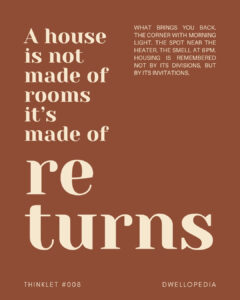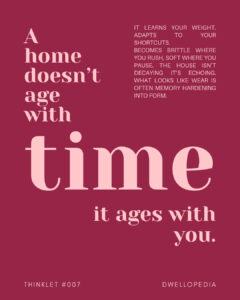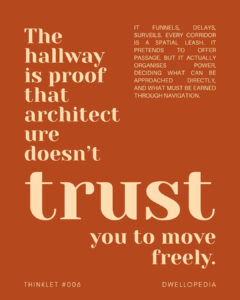In the architecture of shelter, where walls stand firm as sentinels against the unpredictable world, there exists a singular point of paradox—the door. Unlike the steadfast barrier of walls that encase and protect, the door must betray the home’s very purpose by opening, yielding, and inviting the outside in. This architectural contradiction is not a flaw but a fundamental truth: the house begins where it is most vulnerable.
How do we reconcile this delicate tension between protection and openness? What does it mean that the very element designed to secure a home also serves as its diplomatic threshold—welcoming guests, admitting light and air, yet standing ready to resist intrusion? The door is a liminal space, a negotiation between interior sanctuary and external world, between trust and suspicion. It is the silent dialogue at the heart of dwelling.
We install locks and bolts in fear of vulnerability, yet we build thresholds to enable relationship—between residents and visitors, between past and present, between solitude and society. Each door swings open to reveal a world of possibility, while simultaneously guarding the sanctity within. When we pause before crossing a threshold, what are we really negotiating? Safety? Belonging? The fragile trust that defines home?
This thinklet offers no answers—only invitation. It asks architects and thinkers to dwell in this paradox, to reflect on how housing design might deepen its dialogue with the very notion of vulnerability. To rethink the door is to rethink the house itself, the idea of sanctuary, and the lived experience of threshold spaces where inside and outside intertwine.
⸻
Housing Unfolded: Transforming the Practice
If the door is the point where the house must betray its own walls, then housing design must reckon with this inherent contradiction as a source of innovation and meaning. What if instead of treating doors as mere functional apertures, architects embraced them as active agents of spatial and social dialogue? How might this reframe our understanding of home and community?
Doors become more than entry points; they are thresholds of trust and encounter. Imagine housing designed with these thresholds as focal moments, consciously crafted to mediate vulnerability and welcome. The door’s presence invites questions about how residents relate to their surroundings and to each other—about the rhythm of entry and exit, about the gradations between public, semi-private, and private space.
Materiality takes on new significance. The weight of a door, the sound it makes when it swings, the texture under the hand—each detail speaks volumes about invitation or resistance. How might tactile warmth or visual permeability encourage openness, while still signaling boundaries? Light, too, becomes a subtle participant. Translucent panels or sidelights might soften the threshold, diffusing brightness in a way that welcomes without overwhelming.
Spatially, the threshold challenges rigid distinctions between inside and outside. Porches, entry alcoves, vestibules—all architectural strategies that inhabit the door’s paradox. Could we reimagine these spaces as zones of lingering and connection, rather than mere passageways? How might density and intimacy be shaped around these points of vulnerability, fostering community while respecting privacy?
On a social level, the door marks the beginning of relationships—between neighbors, between stranger and resident, between safety and risk. How does the design of thresholds influence this social contract? Could rethinking the door challenge our assumptions about security, encouraging designs that trust rather than exclude? Could we invite a broader cultural dialogue about inclusion through architecture?
These reflections ripple outward. Housing design might move beyond efficiency and enclosure toward fostering empathy and dialogue. The door’s contradiction—the need to both protect and yield—becomes a metaphor for the balance housing must strike in a complex, interconnected world.
⸻
Beyond Boundaries: Layered Understandings
The door’s paradox resonates far beyond its physical function, revealing rich layers of interpretation through varied philosophical and cultural lenses. From sustainability to social equity, memory to technology, this simple architectural element refracts a spectrum of meanings.
From an environmental viewpoint, doors regulate the delicate exchange of energy, air, and light—poised between containment and flow. How might this tension inspire designs that harmonize shelter with nature, embracing permeability rather than resistance? In a time when sustainable housing demands responsiveness, the door’s “betrayal” could be its ecological strength.
Social equity opens another dimension. Doors can be symbols of inclusion or exclusion, gateways that reinforce or dismantle barriers. What stories do thresholds tell about who belongs and who is kept out? How might architectural design of entryways foster social justice, making visible the often-invisible politics of access and exclusion?
Memory and identity also dwell here. Thresholds mark transitions not only of space but of self. The door can carry histories—of families, cultures, neighborhoods. How do the design and experience of doors shape collective memory? Could a door be a vessel of stories, a keeper of lineage?
In the technological age, doors engage with new forms of trust and interaction. Smart locks and digital entry blur lines between intimacy and surveillance, control and convenience. How do these innovations alter our relationship to vulnerability and safety? Do they amplify or diminish the poetic tension the door holds?
Each lens refracts the thought anew, expanding its reach and deepening its complexity. The door ceases to be a static object and becomes a prism of architectural, cultural, and existential reflection. How might embracing this multiplicity enrich housing concepts, architectural theory, and the lived experience of space?
⸻
Conclusion
The door, as the point where the house must betray itself, invites us to rethink vulnerability not as weakness but as a vital architectural and human condition. This thinklet is a seed—planted in the fertile ground of architectural imagination—urging architects, students, and thinkers to embrace uncertainty and paradox in their practice.
As we close this meditation, we do not seek answers but rather open new questions: What if the threshold is the heart of the home, where trust is continuously negotiated? How might we design houses that honor the door’s tension, crafting spaces that both protect and invite? Could the door’s betrayal become a symbol of courage, connection, and radical openness?
In the act of crossing a threshold, we are asked not just to enter space, but to engage with the complexity of belonging, risk, and welcome. The door’s secret lies in this invitation—a perpetual dance between inside and out, self and other, shelter and exposure.
What stories does your door tell about who you trust? And how will you, as an architect or thinker, carry forward the dialogue between vulnerability and sanctuary in your own work?







